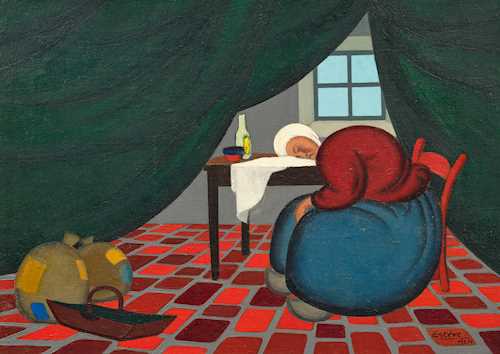
拍品 3223 - A209 印象派&现代主义 - Freitag, 21. Juni 2024, 05.00 PM
MAURICE ESTÈVE
(1904 Culan 2001)
Paysanne endormie aux rideaux verts (premier état). 1924.
Oil on canvas.
Signed and dated lower right: Estève / 1924.
Verso signed, inscribed dated: Estève / Culan, 1924.
Verso signed, inscribed dated: Estève / Culan, 1924.
33 × 46 cm.
Provenance:
- Villand & Galanis, Paris.
- Private collection, Switzerland, acquired 20.7.1971 from the above gallery and thence by descent.
Exhibited:
- Bremen 1974, Maurice Estève, Kunsthalle, 3.2.–3.3.1974.
Literature:
- Pierre Francastel: Estève, Paris 1956 (ill. p. 55).
Maurice Estève began his artistic career with a figurative approach before later turning to the abstract. In his early works, particularly in the 1920s and 1930s, his style is characterized by realism.
Estève was raised in the countryside by his grandparents, who were farmers. This rural childhood nurtured his art profoundly. Only at the age of 13 did he join his parents in Paris, where he visited the Louvre and came into contact with the great painters of the Barbizon School as well as Delacroix and Chardin. But above all, he was fascinated by Paolo Ucello and his painting "Bataille de San Romano". When he finally attended the Free Academy in Montparnasse during the first half of the 1920s and studied intensively the work of Cézanne and the Cubists, Estève began painting on his own.
The present work "Paysanne endormie aux rideaux verts," created in 1924, is one of the artist's earliest works in oils. The influence of his childhood in the country is clearly visible in the motifs. It is also wonderful to see how Estève employs perspective in this work, which can certainly be traced back to his fascination with Ucello, who is considered the father of perspective painting. The artist also uses his first cubist forms here and creates a sense of volume through color nuances.
Although Estève's early works do not yet show the abstraction that would later become his trademark, a sensitivity to color and composition can already be seen in them. These early works laid the foundation for his later development of a more abstract visual language in which colors and shapes acquired greater autonomy and his movement away from the pure depiction of reality.
Estève created two versions of this composition. The work coming to auction is the first and original version. The second is in the Musée Estève in Bourges.
Estève was raised in the countryside by his grandparents, who were farmers. This rural childhood nurtured his art profoundly. Only at the age of 13 did he join his parents in Paris, where he visited the Louvre and came into contact with the great painters of the Barbizon School as well as Delacroix and Chardin. But above all, he was fascinated by Paolo Ucello and his painting "Bataille de San Romano". When he finally attended the Free Academy in Montparnasse during the first half of the 1920s and studied intensively the work of Cézanne and the Cubists, Estève began painting on his own.
The present work "Paysanne endormie aux rideaux verts," created in 1924, is one of the artist's earliest works in oils. The influence of his childhood in the country is clearly visible in the motifs. It is also wonderful to see how Estève employs perspective in this work, which can certainly be traced back to his fascination with Ucello, who is considered the father of perspective painting. The artist also uses his first cubist forms here and creates a sense of volume through color nuances.
Although Estève's early works do not yet show the abstraction that would later become his trademark, a sensitivity to color and composition can already be seen in them. These early works laid the foundation for his later development of a more abstract visual language in which colors and shapes acquired greater autonomy and his movement away from the pure depiction of reality.
Estève created two versions of this composition. The work coming to auction is the first and original version. The second is in the Musée Estève in Bourges.
CHF 40 000 / 60 000 | (€ 41 240 / 61 860)
以瑞士法郎銷售 CHF 50 000 (包含買家佣金)
所有信息随时可能更改。


